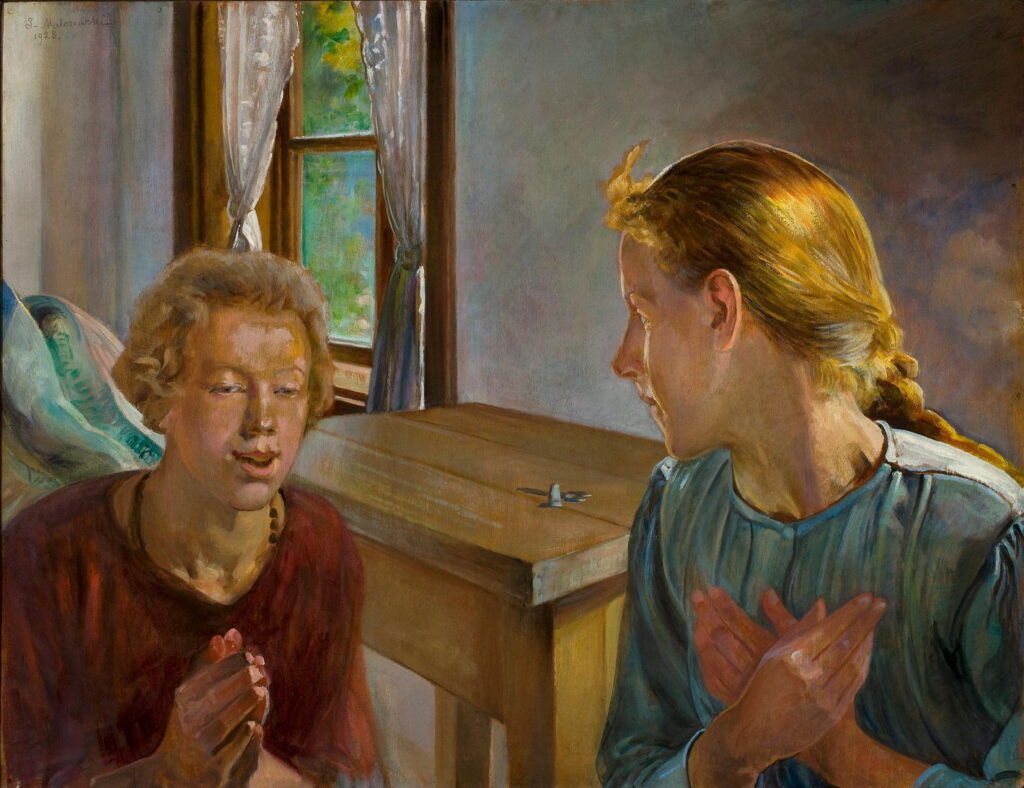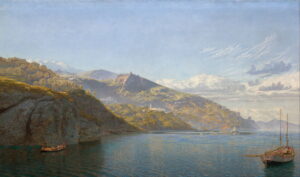Paintings of 1923: 1 Narrative

At the end of each year, I post articles showing a selection of paintings that are believed to have been made one century ago. This gives a fascinating overview of the wide range of styles during some of the most tumultuous years in art. It suffers one bias, though: because of copyright, I’m unable to show the work of painters who died after about 1952. As in previous years, I divide the paintings of 1923 across several articles. In this, I show narrative works, mainly based on myth or religious themes.
Franz von Stuck (1863–1928), The Three Goddesses Athena, Hera and Aphrodite (1923), oil on panel, 73.5 × 74 cm, Private collection. Wikimedia Commons.
Rather than paint the traditional story of the Judgement of Paris, Franz von Stuck chose to show The Three Goddesses Athena, Hera and Aphrodite as if they were three contenders in a beauty contest. These are the three who were judged by Paris leading to the war against Troy. Conventionally, these goddesses are shown with Paris as judge, Hermes, and sundry attendants, often as an opportunity to paint three beautiful nudes on a single canvas. Von Stuck doesn’t duck that, but builds his story to involve the viewer rather than Paris.
Athena, at the left, is shown with her helmet and spear in her Pallas mode, and holds a large shield, her Aegis, on which is the image of the head of the Gorgon Medusa. Hera (centre), both sister and wife of Zeus, adds a little decorum with her crown, and by screening her body from full view with a diaphanous garment. At the right, Aphrodite holds her veil behind her, to ensure that nothing stands in the way of admiring her entire body.
In traditional versions of this story, the goddesses’ bodies are being exposed to Paris for his judgement. By removing him and the attendants and putting the viewer in his position, von Stuck transforms this into the judgement of the viewer, making us think not only about the goddesses and their beauty, but also the consequences of our decision.
Lovis Corinth (1858–1925), Susanna and the Elders (1923), oil on canvas, 150.5 x 111 cm, Niedersächsisches Landesmuseum Hannover, Hanover, Germany. Wikimedia Commons.
Just a couple of years before his death, Lovis Corinth painted his last account of the story of Susanna and the Elders. As in his earlier depictions of this, he still avoids the traditional pastoral or garden setting, but Susanna has turned to confront the elders as they try to blackmail her. This has the disadvantage that we cannot see her facial expression, only the leering smiles of the men.
Jacek Malczewski (1854–1929), Annunciation (1923), oil on plywood, 61 x 79 cm, Muzeum Narodowe w Warszawie, Warsaw, Poland. Wikimedia Commons.
In Jacek Malczewski’s account of the Annunciation, Mary (right) is a modern young woman, whose thimble and scissors rest on a bare wooden table behind. Gabriel is in the midst of breaking the news to her, his hands held together as he speaks. The window and curtains make clear that this is twentieth century Poland, not the Holy Land two millennia ago.
Henry Ossawa Tanner (1859–1937), Flight into Egypt (1923), oil on canvas, 73.7 × 66 cm, Metropolitan Museum of Art, New York, NY. Wikimedia Commons.
This, Henry Ossawa Tanner’s second version of the Flight into Egypt, is a nocturne following Adam Elsheimer’s example, but sets a totally different scene in the narrow street of a town. He uses light skilfully, with the cast shadow creating the effect of a halo around Mary’s head, as she cradles the infant Jesus on her donkey.
Albin Egger-Lienz (1868–1926), Resurrection (1923), oil on cardboard, 71.5 x 101 cm, location not known. Wikimedia Commons.
In 1923-24, Albin Egger-Lienz painted a thoroughly modern account of the Resurrection of Christ. He developed the study above into the finished painting below, with its contemporary peasants and the risen Christ standing in his own coffin.
Albin Egger-Lienz (1868–1926), Resurrection of Christ (1923-24), oil on canvas, 197 x 247 cm, Tirol Art Museum, Austria. Wikimedia Commons.
Edmond Aman-Jean (1858–1936), Festival of Venice (1923), oil on canvas, 214 x 430 cm, Ohara Museum of Art 大原美術館, Kurashiki, Japan. Wikimedia Commons.
Edmond Aman-Jean’s Festival of Venice contains more subtle narrative, and is set at an open-air performance involving a Harlequin character with a moustache, who is offering a woman a pink flower, presumably in an effort to woo her. At the right is a chorus of three women, and another sits in a chair at the far right asleep. A young woman seated at the front of the wooden stage is playing a hurdy gurdy, and a girl to the left of her is making a floral decoration. This is a modern retelling of the commedia dell’arte at the event that it had first become popular in the mid-sixteenth century.
Despite their wide range of styles, each of these narrative paintings tells its conventional if not well-worn story in a modern manner or setting. Who claimed that narrative painting had died in the nineteenth century?




